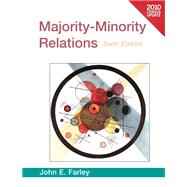
Note: Supplemental materials are not guaranteed with Rental or Used book purchases.
Purchase Benefits
What is included with this book?
John E. Farley is Professor Emeritus in the Department of Sociology and Criminal Justice Studies at Southern Illinois University Edwardsville, where for nearly thirty years he taught a wide range of courses, including many years of teaching the race and ethnic relations course. He conducted his undergraduate studies at Michigan State University, where he received a B.A. in political science. He continued his studies at the University of Michigan, where he received an M.A. and a Ph.D. in sociology, as well as the master of urban planning degree.
He is also the author of Sociology, Fifth Edition (Prentice Hall, 2003). He is an active researcher in urban sociology and race and ethnic relations, and his articles have appeared in the American Journal of Sociology, Social Science Research, the American Journal of Economics and Sociology, Urban Affairs Review, The Sociological Quarterly, Contexts, and a number of other journals. He also regularly presents the results of his research at professional meetings, and has addressed such meetings in Canada, Sweden and Germany as well as throughout the United States. He headed a research team studying public response to Iben Browning’s prediction of an earthquake in the Midwest in 1990, and he was editor of a special issue of the nternational Journal of Mass Emergencies and Disasters on that topic. His book, Earthquake Fears, Predictions, and Preparations in Mid-America, which reports the results of the three-year study, was published by Southern Illinois University Press in 1998. Dr. Farley has conducted research on racial housing segregation based on each U.S. census from 1980 through 2000. He has received research grants from the National Science Foundation, the National Institute of Mental Health, and SIUE’s Graduate School and Institute for Urban Research.
Professor Farley has received a number of awards for his work, including the SIUE Outstanding Scholar Award for his research on race relations and racial housing segregation, the SIUE Kimmell Community Service Award for his efforts in creating a fair housing organization in the St. Louis metropolitan area, and SIUE’s Dr. Martin Luther King, Jr., University Humanitarian Award for his efforts in the community. He has served as president of the SIUE Faculty Senate, the Illinois Sociological Association, the Midwest Sociological Society, and the Metropolitan St. Louis Equal Housing Opportunity Council, which presented him with its Open Doors Award in 2008 for his work promoting fair housing. Dr. Farley enjoys fishing, snow skiing, travel, and nature and weather photography, especially when sharing these activities with his wife, Alice and his daughter, Megan. In 2004, he became a grandfather, and now has two grandchildren.
IN THIS SECTION:
1.) BRIEF
2.) COMPREHENSIVE
BRIEF TABLE OF CONTENTS:
Chapter 1: Orientation: Basic Terms and Concepts
Part I: Social-Psychology and Social Structure as Ways of Understanding Majority-Minority Relations
Chapter 2: Prejudice: Its Forms and Causes
Chapter 3: Reducing Prejudice: How Achievable? How Important?
Chapter 4: Macro-Sociological Perspectives: The Order and Conflict Models
Part II: The Historical Roots of Today’s Intergroup Inequality and Majority-Minority Relations
Chapter 5: Origins and Causes of Ethnic Inequality
Chapter 6: Changing Patterns of Majority-Minority Relations in the United States
Chapter 7: Minority Group Movements and Their Impact on Society
Chapter 8: Changing Values, Goals, and Models: New Thinking on Assimilation, Pluralism, and Separatism
Chapter 9: Cross-Cultural Studies of Majority-Minority Relations
Part III: Majority-Minority Relations in America Today: The Role of Institutional Discrimination
Chapter 10: The Status of Majority and Minority Groups in the United States Today
Chapter 11: The Economic and Health Care Systems and Minority Groups in America
Chapter 12: Living Apart: Housing Segregation in America
Chapter 13: The American Political and Legal System and Majority-Minority Relations
Chapter 14: Education and American Minority Groups
Part IV: Current and Future Issues in Majority-Minority Relations
Chapter 15: Current Trends in Majority-Minority Relations
Chapter 16: Current Debates: Affirmative Action, Immigration, and Race Versus Class
The New copy of this book will include any supplemental materials advertised. Please check the title of the book to determine if it should include any access cards, study guides, lab manuals, CDs, etc.
The Used, Rental and eBook copies of this book are not guaranteed to include any supplemental materials. Typically, only the book itself is included. This is true even if the title states it includes any access cards, study guides, lab manuals, CDs, etc.